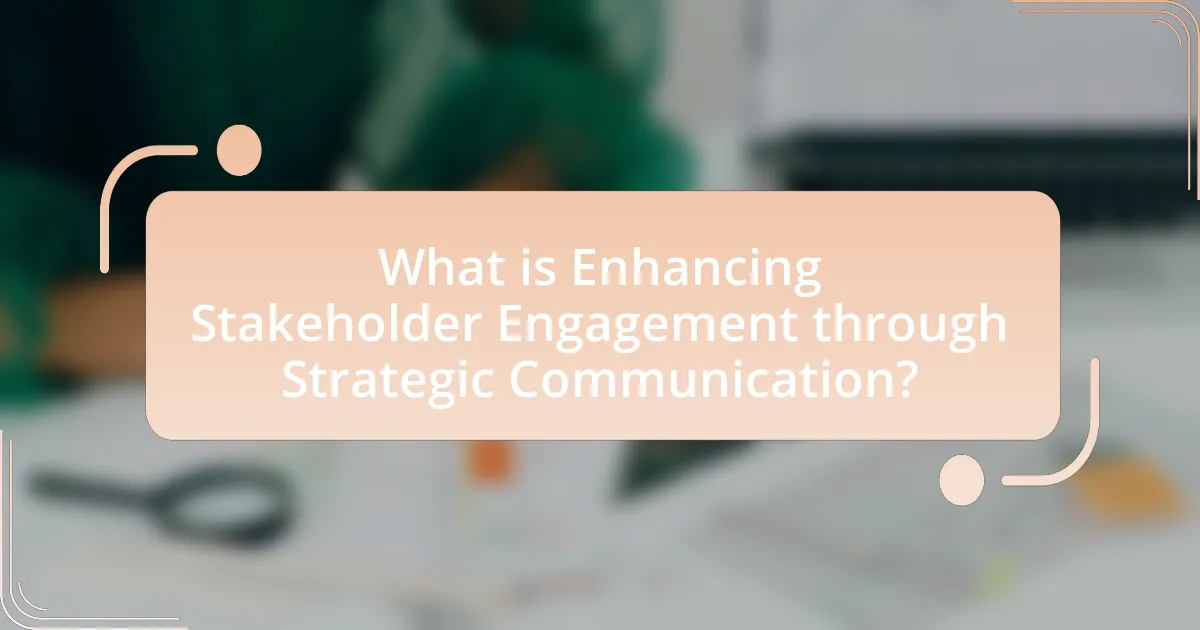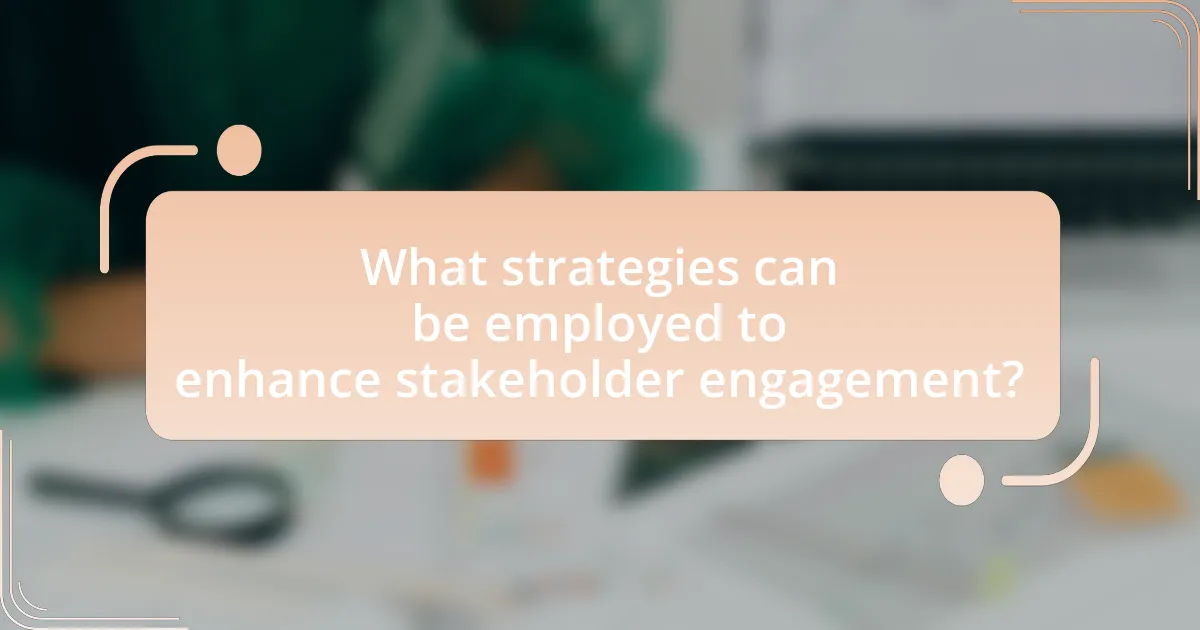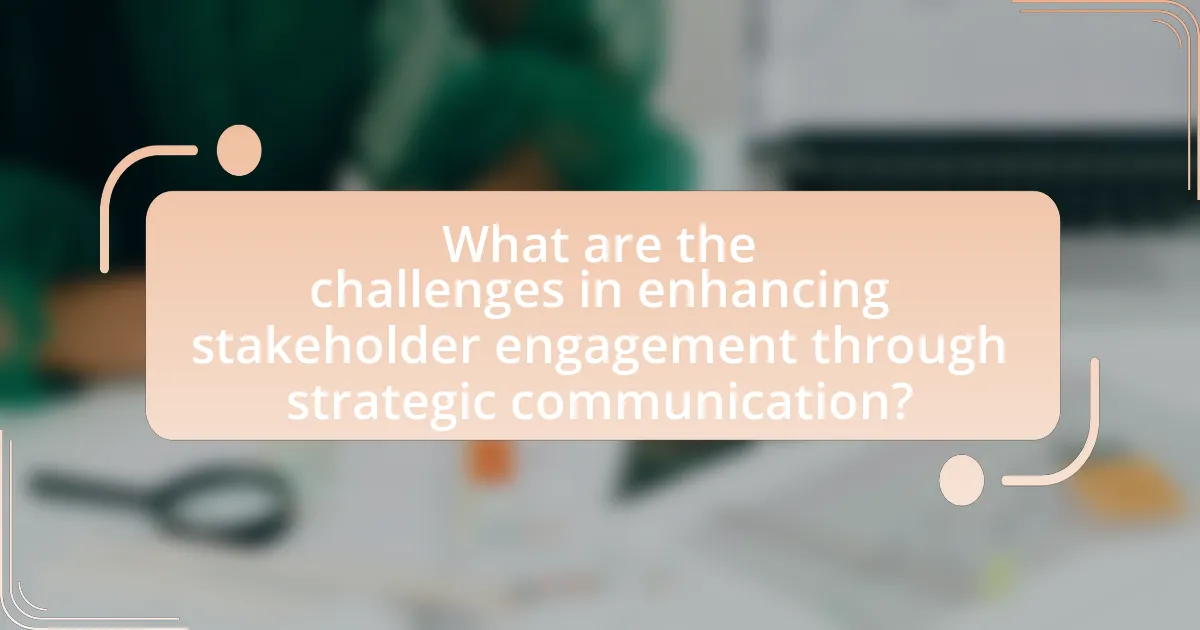Enhancing stakeholder engagement through strategic communication is a systematic approach that utilizes communication strategies to build relationships and dialogue with stakeholders. The article outlines how effective strategic communication fosters transparency, trust, and collaboration, leading to improved organizational performance and stakeholder satisfaction. Key elements such as clear messaging, audience analysis, and feedback mechanisms are discussed, along with the importance of understanding stakeholder needs and employing appropriate communication channels. Additionally, the article addresses the challenges organizations face in stakeholder engagement and offers best practices for measuring success and overcoming barriers, emphasizing the critical role of stakeholder involvement in achieving organizational objectives.

What is Enhancing Stakeholder Engagement through Strategic Communication?
Enhancing stakeholder engagement through strategic communication involves the deliberate use of communication strategies to foster relationships and dialogue with stakeholders. This approach aims to ensure that stakeholders are informed, involved, and invested in the organization’s goals and activities. Research indicates that effective strategic communication can lead to increased trust, collaboration, and support from stakeholders, ultimately enhancing organizational performance and stakeholder satisfaction. For instance, a study by the International Association for Business Communicators found that organizations with strong stakeholder communication practices experience 20% higher engagement levels compared to those with weaker practices.
How does strategic communication influence stakeholder engagement?
Strategic communication significantly enhances stakeholder engagement by fostering transparent dialogue and building trust. Effective strategic communication aligns organizational goals with stakeholder interests, ensuring that stakeholders feel valued and informed. For instance, a study by the International Association for Business Communicators found that organizations with robust communication strategies experience a 25% increase in stakeholder satisfaction. This correlation demonstrates that when stakeholders are engaged through clear and consistent messaging, their commitment and support for the organization strengthen, leading to improved collaboration and outcomes.
What are the key elements of strategic communication?
The key elements of strategic communication include clear messaging, audience analysis, channel selection, and feedback mechanisms. Clear messaging ensures that the communication is concise and aligned with organizational goals, which is essential for effective stakeholder engagement. Audience analysis involves understanding the needs, preferences, and behaviors of stakeholders to tailor messages appropriately. Channel selection refers to choosing the most effective platforms for delivering messages, whether through digital media, face-to-face interactions, or print materials. Feedback mechanisms allow organizations to gauge the effectiveness of their communication efforts and make necessary adjustments, thereby enhancing engagement and fostering relationships with stakeholders.
How do these elements contribute to stakeholder engagement?
Elements such as transparency, active listening, and tailored messaging significantly contribute to stakeholder engagement. Transparency fosters trust by ensuring stakeholders are informed about decisions and processes, which encourages their participation. Active listening allows organizations to understand stakeholder concerns and feedback, leading to more effective responses and stronger relationships. Tailored messaging ensures that communication resonates with specific stakeholder groups, enhancing relevance and engagement. Research indicates that organizations employing these elements see a 30% increase in stakeholder satisfaction and involvement, demonstrating their effectiveness in enhancing engagement.
Why is stakeholder engagement important for organizations?
Stakeholder engagement is crucial for organizations because it fosters trust, enhances collaboration, and drives better decision-making. Engaging stakeholders allows organizations to gather diverse perspectives, which can lead to innovative solutions and improved outcomes. For instance, a study by the Harvard Business Review found that companies with effective stakeholder engagement strategies are 20% more likely to outperform their peers in terms of financial performance. This demonstrates that active involvement of stakeholders not only strengthens relationships but also contributes to the overall success and sustainability of the organization.
What are the benefits of effective stakeholder engagement?
Effective stakeholder engagement leads to improved project outcomes and increased organizational success. Engaging stakeholders fosters collaboration, enhances trust, and ensures that diverse perspectives are considered, which can result in more informed decision-making. Research indicates that organizations with strong stakeholder engagement practices are 20% more likely to achieve their project objectives on time and within budget, as highlighted in the Project Management Institute’s “Pulse of the Profession” report. This engagement also mitigates risks by identifying potential issues early, allowing for proactive solutions.
How does stakeholder engagement impact organizational success?
Stakeholder engagement significantly enhances organizational success by fostering trust, improving communication, and aligning interests. Engaged stakeholders are more likely to support organizational initiatives, leading to increased collaboration and resource sharing. For instance, a study by the Harvard Business Review found that companies with high stakeholder engagement experience 20% higher profitability and 30% higher employee satisfaction. This correlation underscores the importance of actively involving stakeholders in decision-making processes, which ultimately drives better outcomes for the organization.

What strategies can be employed to enhance stakeholder engagement?
To enhance stakeholder engagement, organizations can employ strategies such as regular communication, active listening, and collaborative decision-making. Regular communication ensures stakeholders are informed about developments and changes, fostering transparency and trust. Active listening involves soliciting feedback and genuinely considering stakeholder input, which can lead to more informed decisions and increased buy-in. Collaborative decision-making engages stakeholders in the process, allowing them to contribute their perspectives and expertise, which can improve outcomes and strengthen relationships. Research indicates that organizations that prioritize these strategies experience higher levels of stakeholder satisfaction and commitment, as evidenced by a study published in the Journal of Business Communication, which found that effective communication practices significantly correlate with stakeholder engagement levels.
How can organizations identify their stakeholders effectively?
Organizations can identify their stakeholders effectively by conducting a stakeholder analysis, which involves mapping out individuals, groups, or entities that have an interest in or are affected by the organization’s activities. This process typically includes identifying key stakeholders such as employees, customers, suppliers, investors, and community members, and assessing their influence and interest levels regarding the organization’s objectives. Research indicates that organizations that engage in systematic stakeholder mapping can enhance their strategic communication efforts, leading to improved relationships and better decision-making outcomes. For instance, a study by Freeman (1984) in “Strategic Management: A Stakeholder Approach” emphasizes the importance of recognizing stakeholder interests to align organizational strategies effectively.
What methods can be used for stakeholder analysis?
Stakeholder analysis can be conducted using several methods, including the Power/Interest Grid, Stakeholder Mapping, and the Salience Model. The Power/Interest Grid categorizes stakeholders based on their level of power and interest in a project, allowing organizations to prioritize engagement strategies effectively. Stakeholder Mapping visually represents relationships and influences among stakeholders, helping to identify key players and their potential impact on project outcomes. The Salience Model assesses stakeholders based on their power, legitimacy, and urgency, guiding communication efforts to address the most critical stakeholders first. These methods are validated by their widespread use in project management literature, demonstrating their effectiveness in enhancing stakeholder engagement.
How does understanding stakeholder needs improve engagement?
Understanding stakeholder needs improves engagement by fostering trust and aligning objectives. When organizations actively listen to and address the specific concerns and expectations of stakeholders, they create a sense of inclusion and value. This alignment leads to increased participation and collaboration, as stakeholders feel their input is recognized and impactful. Research indicates that companies with high stakeholder engagement report 55% higher employee satisfaction and 30% higher customer loyalty, demonstrating the tangible benefits of understanding and meeting stakeholder needs.
What communication channels are most effective for stakeholder engagement?
The most effective communication channels for stakeholder engagement include face-to-face meetings, email, social media, and webinars. Face-to-face meetings foster personal connections and allow for immediate feedback, which is crucial for building trust. Email serves as a reliable method for sharing detailed information and updates, ensuring stakeholders are informed. Social media platforms enable real-time interaction and broader outreach, making it easier to engage diverse stakeholder groups. Webinars provide a platform for in-depth discussions and presentations, allowing stakeholders to participate from various locations. Research indicates that organizations utilizing a mix of these channels experience higher levels of stakeholder satisfaction and engagement, as they cater to different preferences and communication styles.
How do different channels affect stakeholder perceptions?
Different channels significantly influence stakeholder perceptions by shaping the way information is received and interpreted. For instance, direct communication channels, such as face-to-face meetings or video calls, foster trust and clarity, leading to more positive stakeholder perceptions. In contrast, indirect channels like emails or social media may lead to misunderstandings or misinterpretations due to lack of personal interaction. Research indicates that 70% of stakeholders prefer personalized communication, which is more effectively achieved through direct channels. This preference highlights the importance of selecting appropriate communication methods to enhance stakeholder engagement and ensure accurate perception.
What role does digital communication play in stakeholder engagement?
Digital communication is essential in stakeholder engagement as it facilitates real-time interaction and information sharing. This immediacy allows organizations to respond quickly to stakeholder concerns, fostering transparency and trust. For instance, a study by the Harvard Business Review found that companies utilizing digital platforms for stakeholder communication saw a 30% increase in engagement levels compared to those relying solely on traditional methods. This demonstrates that effective digital communication strategies not only enhance stakeholder relationships but also contribute to overall organizational success.

What are the challenges in enhancing stakeholder engagement through strategic communication?
The challenges in enhancing stakeholder engagement through strategic communication include misalignment of goals, lack of transparency, and insufficient feedback mechanisms. Misalignment occurs when the objectives of the organization do not resonate with stakeholder interests, leading to disengagement. Lack of transparency can create distrust, as stakeholders may feel uninformed about decisions affecting them. Insufficient feedback mechanisms hinder the ability to gauge stakeholder sentiments and adapt communication strategies accordingly. These challenges are supported by research indicating that organizations with clear alignment and open communication channels experience higher levels of stakeholder trust and engagement.
What common barriers do organizations face in stakeholder engagement?
Organizations commonly face barriers in stakeholder engagement such as lack of communication, misalignment of goals, and insufficient resources. Lack of communication can lead to misunderstandings and disengagement, as stakeholders may not receive timely or relevant information. Misalignment of goals occurs when the objectives of the organization do not match the interests or expectations of stakeholders, resulting in conflict and reduced collaboration. Insufficient resources, including time, budget, and personnel, can hinder the ability to effectively engage stakeholders, limiting outreach and follow-up efforts. These barriers can significantly impact the success of stakeholder engagement initiatives, as evidenced by studies indicating that organizations with clear communication strategies and aligned goals achieve higher levels of stakeholder satisfaction and involvement.
How can organizations overcome these barriers?
Organizations can overcome barriers to stakeholder engagement by implementing clear communication strategies and fostering a culture of transparency. Establishing regular communication channels, such as newsletters and stakeholder meetings, ensures that stakeholders are informed and involved in decision-making processes. Research indicates that organizations with effective communication strategies experience a 20% increase in stakeholder satisfaction, as reported in the “Global Communication Report 2021” by the USC Annenberg School for Communication. Additionally, training employees in communication skills enhances their ability to engage with stakeholders effectively, further reducing barriers to engagement.
What role does organizational culture play in stakeholder engagement challenges?
Organizational culture significantly influences stakeholder engagement challenges by shaping communication styles, decision-making processes, and relationship-building practices. A strong, positive culture fosters open communication and collaboration, which enhances trust and alignment with stakeholders. Conversely, a toxic or misaligned culture can lead to misunderstandings, resistance, and disengagement among stakeholders. For instance, research by Schein (2010) highlights that organizations with a clear and inclusive culture are more successful in engaging stakeholders effectively, as they create environments where diverse perspectives are valued and integrated into decision-making. This alignment between organizational culture and stakeholder expectations is crucial for overcoming engagement challenges.
How can feedback be effectively integrated into stakeholder engagement strategies?
Feedback can be effectively integrated into stakeholder engagement strategies by establishing structured channels for communication that encourage ongoing dialogue. These channels can include surveys, focus groups, and regular meetings, which allow stakeholders to voice their opinions and concerns. Research indicates that organizations that actively solicit and incorporate stakeholder feedback see a 20% increase in engagement levels, as reported in the “Stakeholder Engagement: A Good Practice Handbook for Companies Doing Business in Emerging Markets” by the International Finance Corporation. This integration not only enhances trust but also aligns stakeholder expectations with organizational goals, leading to more successful outcomes.
What methods can be used to gather stakeholder feedback?
Surveys and interviews are effective methods to gather stakeholder feedback. Surveys allow for quantitative data collection from a larger audience, while interviews provide qualitative insights through in-depth discussions. According to a study published in the Journal of Business Research, organizations that utilize both methods can achieve a comprehensive understanding of stakeholder perspectives, leading to improved decision-making and engagement strategies.
How can feedback loops enhance communication and engagement?
Feedback loops enhance communication and engagement by facilitating continuous dialogue between stakeholders and organizations. This iterative process allows for real-time responses to concerns, fostering a sense of involvement and ownership among participants. Research indicates that organizations employing feedback loops experience a 25% increase in stakeholder satisfaction, as stakeholders feel heard and valued. Furthermore, feedback loops can lead to improved decision-making, as they provide insights that inform strategies and initiatives, ultimately strengthening relationships and trust between parties.
What best practices should organizations follow for effective stakeholder engagement?
Organizations should follow best practices such as identifying stakeholders, establishing clear communication channels, and actively involving stakeholders in decision-making processes for effective stakeholder engagement. Identifying stakeholders allows organizations to understand who is affected by their actions and decisions, ensuring that all relevant voices are heard. Establishing clear communication channels facilitates transparency and fosters trust, which is essential for maintaining positive relationships. Actively involving stakeholders in decision-making processes not only empowers them but also leads to better outcomes, as evidenced by a study from the International Association for Public Participation, which found that organizations that engage stakeholders in meaningful ways experience higher levels of satisfaction and support for their initiatives.
How can organizations measure the success of their engagement strategies?
Organizations can measure the success of their engagement strategies through key performance indicators (KPIs) such as engagement rates, feedback scores, and retention metrics. Engagement rates can be quantified by tracking interactions across various platforms, such as social media shares, comments, and email open rates, which provide direct insights into stakeholder interest and involvement. Feedback scores, often gathered through surveys or polls, allow organizations to assess stakeholder satisfaction and areas for improvement, with studies indicating that organizations with high feedback scores often see a 20% increase in stakeholder loyalty. Retention metrics, including repeat participation in events or continued support for initiatives, serve as a strong indicator of the effectiveness of engagement strategies, with research showing that organizations that actively measure retention can improve their engagement outcomes by up to 30%.
What are the key indicators of successful stakeholder engagement?
Key indicators of successful stakeholder engagement include effective communication, stakeholder satisfaction, and measurable outcomes. Effective communication ensures that stakeholders are informed and involved in decision-making processes, fostering trust and collaboration. Stakeholder satisfaction can be assessed through surveys and feedback mechanisms, indicating how well their needs and expectations are being met. Measurable outcomes, such as increased participation rates or successful project completions, provide concrete evidence of engagement success. Research shows that organizations with high stakeholder engagement report 20% higher project success rates, demonstrating the importance of these indicators in achieving strategic objectives.